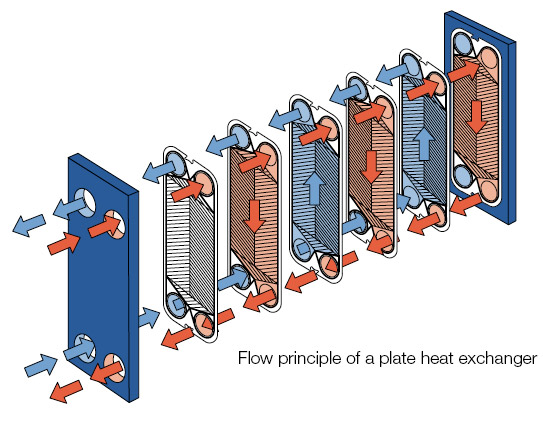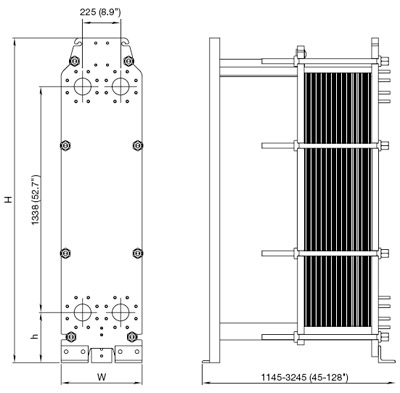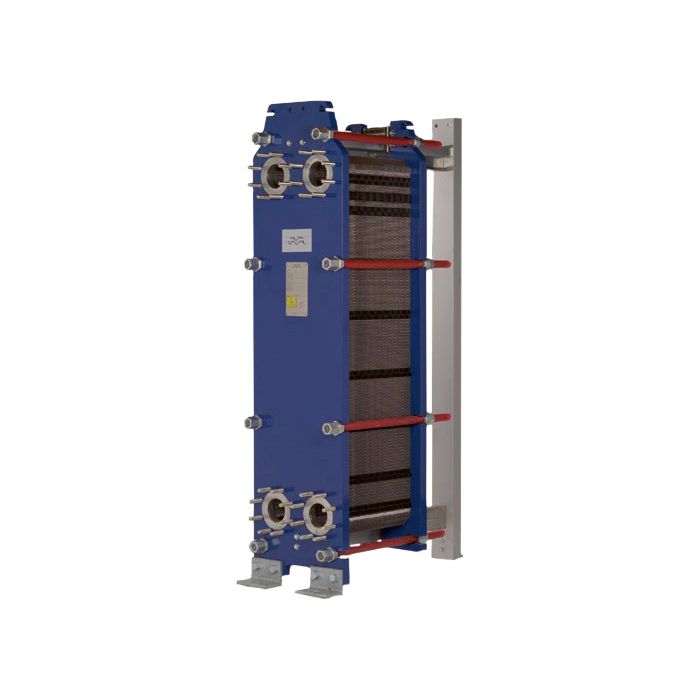TL10 Plate Heat Exchanger
Applications
General heating and cooling duties.
Standard design
The plate heat exchanger consists of a pack of corrugated metal plates with portholes for the passage of the two fluids between which heat transfer will take place.
The plate pack is assembled between a fix frame plate and a movable pressure plate and compressed by tightening bolts. The plates are fitted with a gasket which seals the interplate channel and directs the fluids into alternate channels. The number of plates is determined by the flow rate, physical properties of the fluids, pressure drop and temperature program. The plate corrugations promote fluid turbulence and support the plates against differential pressure.
The plate and the pressure plate are suspended from an upper carrying bar and located by a lower guiding bar, both of which are fixed to a support column.
Connections are located in the frame plate or, if either or both fluids make more than a single pass within the unit, in the frame and pressure plates.
Typical capacities
- Liquid flow rate Up to 50 kg/s (800 gpm), depending on media, permitted pressure drop and temperature program.
- Plate types TL10-B, TL10-P
- Frame types FM, FG and FS

Working principle
Channels are formed between the plates and the corner ports are arranged so that the two media flow through alternate channels. The heat is transferred through the plate between the channels, and complete counter-current flow is created for highest possible efficiency. The corrugation of the plates provides the passage between the plates, supports each plate against the adjacent one and enhances the turbulence, resulting in efficient heat transfer.
STANDARD MATERIALS
- Frame plate Mild steel, Epoxy painted
- Nozzles Carbon steel Metal lined: Stainless steel, Titanium, Alloy 254, Alloy C276, Nickel Rubber lined: Nitrile, EPDM
- Plates Stainless steel: Alloy 304, Alloy 316, Alloy 254, Alloy C276, Nickel, Titanium
- Gaskets NBRB, NBRP, NBRFF, EPDM, EPDMP, EPDMFF, EPDMAL, HNBR, FKMG
Technical data
| Pressure vessel codes, PED, ASME, pvcALS™ Mechanical design pressure (g) / temperature | |||
|---|---|---|---|
| FM | pvcALS™ | 1.0 MPa / 160°C | |
| FG | PED, pvcALS™ | 1.6 MPa / 160°C | |
| FG | ASME | 150 psig / 320°F | |
| FD | PED | 2.5 MPa / 160°C | |
| FS | ASME | 400 psig / 320°F | |
| CONNECTIONS | |||
| FM | pvcALS™ | Size 100 mm | EN 1092, GB, GOST, PN10, ASME CI. 150, JIS 10K |
| FG | PED | Size 100 mm | EN 1092, PN16, ASME CI. 150 |
| FG | pvcALS™ | Size 100 mm | EN 1092, GB, GOST, PN16, ASME CI. 150, JIS 10K |
| FG | ASME | Size 4" | ASME CI. 150 |
| FD | PED | Size 100 mm | EN 1092, PN25, Special square flange |
| FS | ASME | Size 4" | Special square flange |

Maximum heat transfer surface 250 m2 (2700 sq. ft)
| Measurements mm (inch) | |||
|---|---|---|---|
| Type | H | W | h |
| TL10-FM | 1885 (74 3/16") | 480 (19") | 255 (10") |
| TL10-FG | 1981 (78") | 480 (19") | 297 (11 5/8") |
| TL10-FD | 1981 (78") | 480 (19") | 297 (11 5/8") |
| TL10-FS | 1981 (78") | 510 (20") | 297 (11 5/8") |
The number of tightening bolts may vary depending on pressure rating.
Particulars required for quotation
- Flow rates or heat load
- Temperature program
- Physical properties of liquids in question (if not water)
- Desired working pressure
- Maximum permitted pressure drop
Looking for a Plate Heat Exchanger? Click here to find the model you need.
| Flow (L/H) | Various |
|---|

